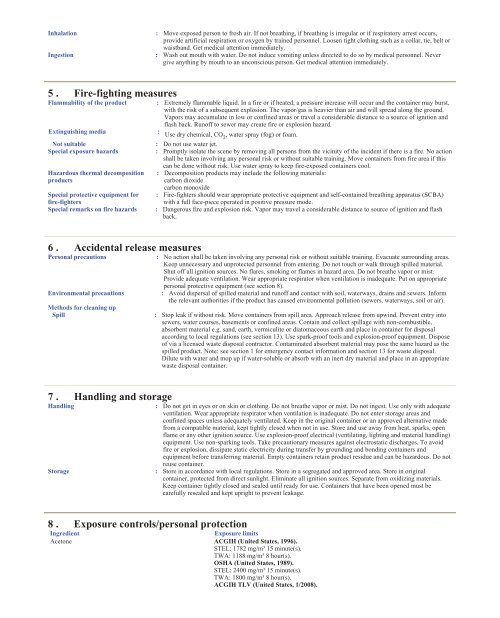Print MSDS - Miller Electric Company Publications
Print MSDS - Miller Electric Company Publications
Print MSDS - Miller Electric Company Publications
Create successful ePaper yourself
Turn your PDF publications into a flip-book with our unique Google optimized e-Paper software.
Inhalation : Move exposed person to fresh air. If not breathing, if breathing is irregular or if respiratory arrest occurs,<br />
provide artificial respiration or oxygen by trained personnel. Loosen tight clothing such as a collar, tie, belt or<br />
waistband. Get medical attention immediately.<br />
Ingestion : Wash out mouth with water. Do not induce vomiting unless directed to do so by medical personnel. Never<br />
give anything by mouth to an unconscious person. Get medical attention immediately.<br />
5 . Fire-fighting measures<br />
Flammability of the product : Extremely flammable liquid. In a fire or if heated, a pressure increase will occur and the container may burst,<br />
with the risk of a subsequent explosion. The vapor/gas is heavier than air and will spread along the ground.<br />
Vapors may accumulate in low or confined areas or travel a considerable distance to a source of ignition and<br />
flash back. Runoff to sewer may create fire or explosion hazard.<br />
Extinguishing media : Use dry chemical, CO2 , water spray (fog) or foam.<br />
Not suitable : Do not use water jet.<br />
Special exposure hazards : Promptly isolate the scene by removing all persons from the vicinity of the incident if there is a fire. No action<br />
shall be taken involving any personal risk or without suitable training. Move containers from fire area if this<br />
Hazardous thermal decomposition<br />
products<br />
can be done without risk. Use water spray to keep fire-exposed containers cool.<br />
: Decomposition products may include the following materials:<br />
carbon dioxide<br />
carbon monoxide<br />
Special protective equipment for : Fire-fighters should wear appropriate protective equipment and self-contained breathing apparatus (SCBA)<br />
fire-fighters<br />
with a full face-piece operated in positive pressure mode.<br />
Special remarks on fire hazards : Dangerous fire and explosion risk. Vapor may travel a considerable distance to source of ignition and flash<br />
back.<br />
6 . Accidental release measures<br />
Personal precautions : No action shall be taken involving any personal risk or without suitable training. Evacuate surrounding areas.<br />
Keep unnecessary and unprotected personnel from entering. Do not touch or walk through spilled material.<br />
Shut off all ignition sources. No flares, smoking or flames in hazard area. Do not breathe vapor or mist.<br />
Provide adequate ventilation. Wear appropriate respirator when ventilation is inadequate. Put on appropriate<br />
personal protective equipment (see section 8).<br />
Environmental precautions : Avoid dispersal of spilled material and runoff and contact with soil, waterways, drains and sewers. Inform<br />
the relevant authorities if the product has caused environmental pollution (sewers, waterways, soil or air).<br />
Methods for cleaning up<br />
Spill : Stop leak if without risk. Move containers from spill area. Approach release from upwind. Prevent entry into<br />
sewers, water courses, basements or confined areas. Contain and collect spillage with non-combustible,<br />
absorbent material e.g. sand, earth, vermiculite or diatomaceous earth and place in container for disposal<br />
according to local regulations (see section 13). Use spark-proof tools and explosion-proof equipment. Dispose<br />
of via a licensed waste disposal contractor. Contaminated absorbent material may pose the same hazard as the<br />
spilled product. Note: see section 1 for emergency contact information and section 13 for waste disposal.<br />
Dilute with water and mop up if water-soluble or absorb with an inert dry material and place in an appropriate<br />
waste disposal container.<br />
7 . Handling and storage<br />
Handling : Do not get in eyes or on skin or clothing. Do not breathe vapor or mist. Do not ingest. Use only with adequate<br />
ventilation. Wear appropriate respirator when ventilation is inadequate. Do not enter storage areas and<br />
confined spaces unless adequately ventilated. Keep in the original container or an approved alternative made<br />
from a compatible material, kept tightly closed when not in use. Store and use away from heat, sparks, open<br />
flame or any other ignition source. Use explosion-proof electrical (ventilating, lighting and material handling)<br />
equipment. Use non-sparking tools. Take precautionary measures against electrostatic discharges. To avoid<br />
fire or explosion, dissipate static electricity during transfer by grounding and bonding containers and<br />
equipment before transferring material. Empty containers retain product residue and can be hazardous. Do not<br />
reuse container.<br />
Storage : Store in accordance with local regulations. Store in a segregated and approved area. Store in original<br />
container, protected from direct sunlight. Eliminate all ignition sources. Separate from oxidizing materials.<br />
Keep container tightly closed and sealed until ready for use. Containers that have been opened must be<br />
carefully resealed and kept upright to prevent leakage.<br />
8 . Exposure controls/personal protection<br />
Ingredient Exposure limits<br />
Acetone ACGIH (United States, 1996).<br />
STEL: 1782 mg/m³ 15 minute(s).<br />
TWA: 1188 mg/m³ 8 hour(s).<br />
OSHA (United States, 1989).<br />
STEL: 2400 mg/m³ 15 minute(s).<br />
TWA: 1800 mg/m³ 8 hour(s).<br />
ACGIH TLV (United States, 1/2008).



